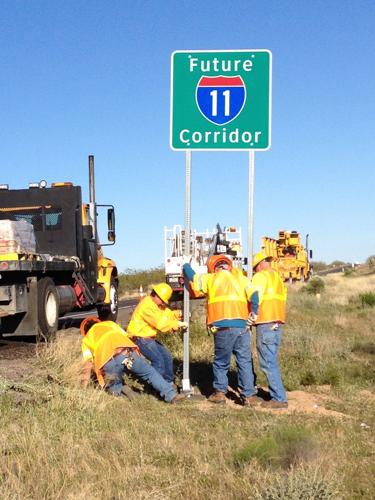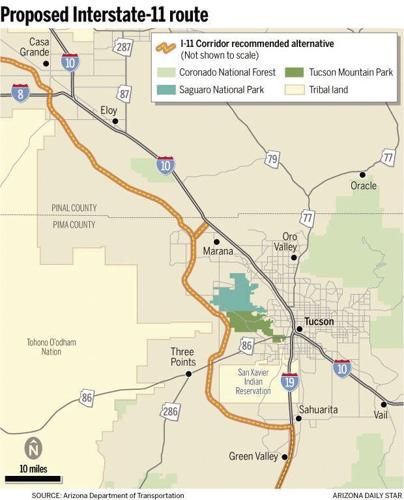A challenge to plans to build the 280-mile Interstate 11 project from Nogales to Wickenburg has survived a key legal challenge.
In a new ruling, U.S. District Court Judge John Hinderaker rejected arguments by the Federal Highway Administration and the Arizona Department of Transportation that any legal objection is premature.
The federal agency insisted no final decisions have been made on where to place the new road, but the judge in Tucson said it appears a route is decided on and the project will move forward.
Hinderaker said it is clear the Federal Highway Administration, which makes the initial determination, already concluded that neither the Ironwood Forest nor Sonoran Desert national monuments qualified for special consideration under federal law that would require the agency to study whether the highway should be placed elsewhere.
He also said there was no analysis done on the ecological impacts to Saguaro National Park or Tucson Mountain Park based on the agency’s conclusion that neither property is a wildlife or waterfowl refuge.
Hinderaker said documents show that properties designated, after initial reviews, as not entitled to protection in highway placement determinations “kept their unprotected designations even after feedback from the Bureau of Land Management, the National Park Service, and Arizona Game and Fish, among others.’’
That’s relevant, the judge said, because it appears some decisions already were made.

The evidence appears to show the Federal Highway Administration foreclosed any alternatives outside the corridor being considered unless new conditions arise, the judge said.
He said the formal “Record of Decision’’ by the agency “seems to acknowledge that the project, and the selected alternative corridor, will move forward notwithstanding objections from agencies following the draft and final environmental impact statements.’’
That entitles those decisions to be challenged now, before there is a final decision, Hinderaker said.
Controversial route in Tucson area
Central to the dispute is the decision by the federal agency to approve one alternative route around the west side of Tucson.
That decision, according to various environmental groups, failed to consider destruction to the Sonoran Desert, harm to wildlife and effects on air pollution. By contrast, they say, those effects would be less if the highway is co-located with existing stretches of interstates 19 and 10.
Attorney Wendy Park, representing the Tucson-based Center for Biological Diversity, which filed the lawsuit, said the federal agency “skewed the comparison of alternatives’’ against selecting that “no-build alternative.’’ The Coalition for Sonoran Desert Protection, the Friends of Ironwood Forest and the Tucson Audubon Society joined the lawsuit.
The plan has been defended by the Arizona Department of Transportation.
In a filing with the court last year, John Haikowski, who had been ADOT director, said that without an alternative to I-10, traffic will become so congested by 2035 that it will interfere with the ability of the region to function.
“Further, the success of the state economic development interests will depend on continuing transportation investments, like I-11, to maintain competitiveness,’’ he said then. “Worsened congestion and poor travel time reliability on the interstate freeway system would adversely affect economic competitiveness.’’
The project, which could cost anywhere from $3.1 billion to $7.3 billion, depending on the final path, also had the backing of former Gov. Doug Ducey, who has said the highway would “really benefit our state and allow us to be the player that we’re going to be in terms of economic growth and development and trade.’’
There was no response Thursday from a spokesman for current Gov. Katie Hobbs about whether she supports the project.
A spokesman for ADOT sidestepped the question of whether his department continues to support the highway. Instead, Jonathan Brodsky said ADOT’s focus with I-11 and other projects “continues to be balancing all needs including land use, environmental and population, commerce, employment and traffic, along with an ongoing commitment to work with stakeholders.’’
Anyway, he said, there currently are no funds to advance further study of the route for the road.
‘Largely unfunded’
In seeking to throw out the challenge, attorneys for the Federal Highway Administration raised similar arguments, telling Hinderaker the case is premature. At this point, they said, no decisions have been made about what route to choose through Pima County — or even whether the project will ever go forward — calling I-11 “a largely unfunded freeway construction project.’’
Park, however, said that misrepresents the situation.
“The Record of Decision committed FHWA to development of the I-11 corridor over the ‘no build’ alternative, selected the vast majority of its route, and narrowed the potential routes through Pima County to either the ‘West’ or ‘East Option,’” she said in her legal filings. That occurred without the federal agency properly completing legally necessary evaluations of impacts of either choice on public lands, she said.
Hinderaker, in his new ruling, said there’s enough in the challenge to let the case proceed.
“Plaintiffs plead cognizable (federal law) violations in their complaint alleging defendants failed to identify all lands protected under (the law), failed to determine how severely each property would be harmed, and failed to examine all feasible and prudent alternatives before comparing and eliminating alternatives,’’ he wrote.
It isn’t just the options of where the road will be located in Southern Arizona that are at issue.
Park said a stretch between Casa Grande and Buckeye also would affect recreation areas as well as habitats for various endangered species. She said there also would be environmental effects from the final stretch from Buckeye to Wickenburg.
The project, which eventually would run through Kingman and into Nevada, has proponents including local officials in Casa Grande and Maricopa who see it as aiding economic development.
Get your morning recap of today's local news and read the full stories here: http://tucne.ws/morning






